Hot Tips To Prevent Cold Trail Riding…
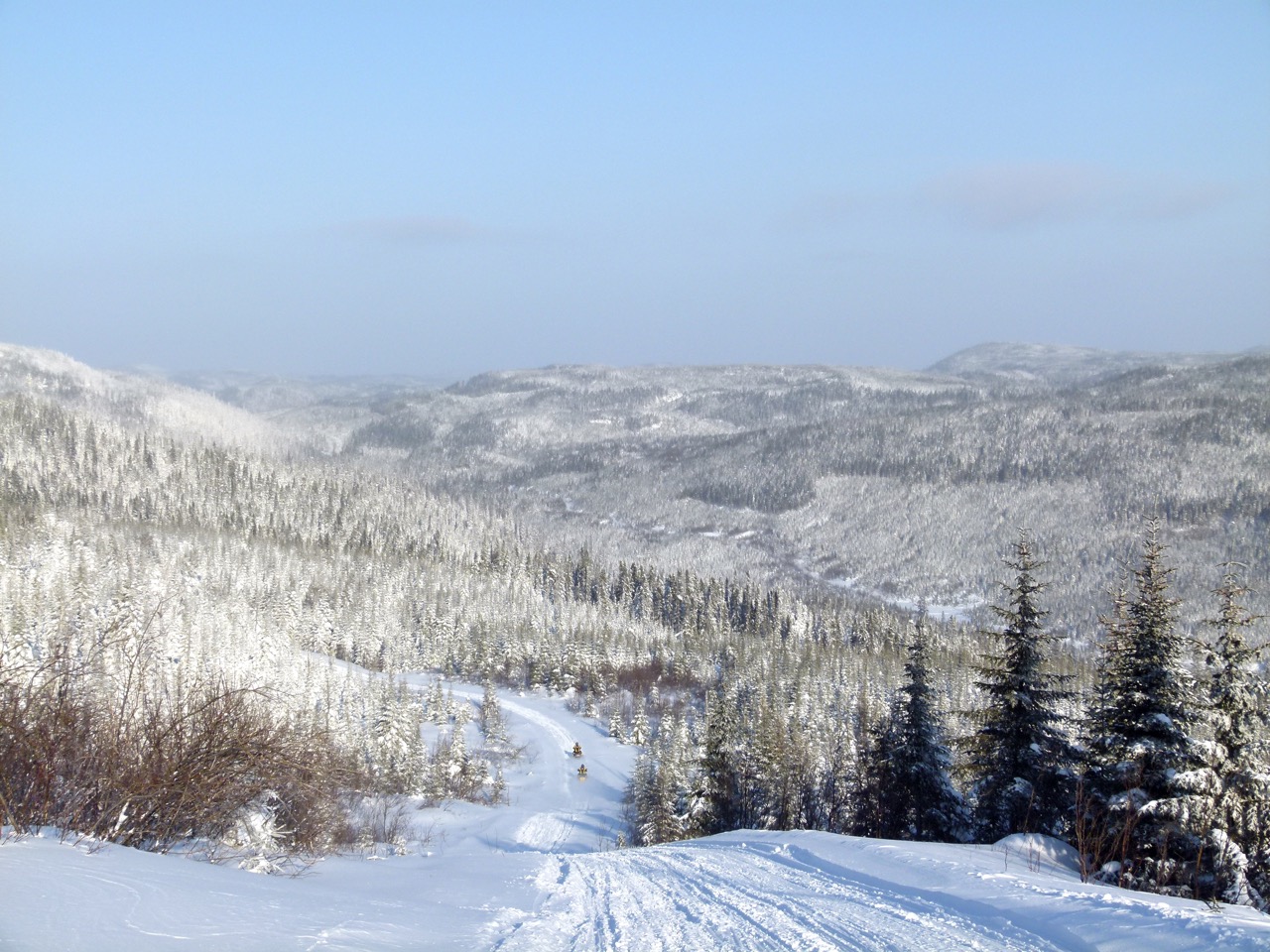
Photo © by Craig Nicholson
Related: 2021 Trail Riding Tips
Do we really appreciate how important staying warm while snowmobiling for the day is? Regardless of whether we’re riding from home or cottage, staying warm should be top of mind.
Anyone who’s ever frozen their buns off on the trail knows what I’m saying. Same goes if you’ve been caught on a family trail ride with miserable loved ones that can’t seem to get warm. So how much more difficult will staying warm while snowmobiling be this year?
Staying Warm While Snowmobiling Means Becoming Self-Sufficient

Photo © by Craig Nicholson
Normally, we take staying warm while snowmobiling pretty much for granted. After all, top notch cold weather gear, heated hand grips and thumb warmers, high windshields, heated seats, handlebar muffs and chemical warmers are available to combat the cold. Plus, we are typically able to take the chill off at many warm up shelters, clubhouses, restaurants and gas stations.
But what if we don’t ride with any or all of this warming equipment? And what if the temperature’s colder than we dressed for?
The watchword for our trail riding each winter is SELF-SUFFICIENT. So, we have to be prepared to be totally self-reliant on every ride, just in case. So, having a good fallback plan will enable us to finish our ride independently, and as comfortably as possible. And it all starts with staying warm while snowmobiling, so here’s my advice to keep the heat flowing longer…
Staying Warm While Snowmobiling Means Starting Warm
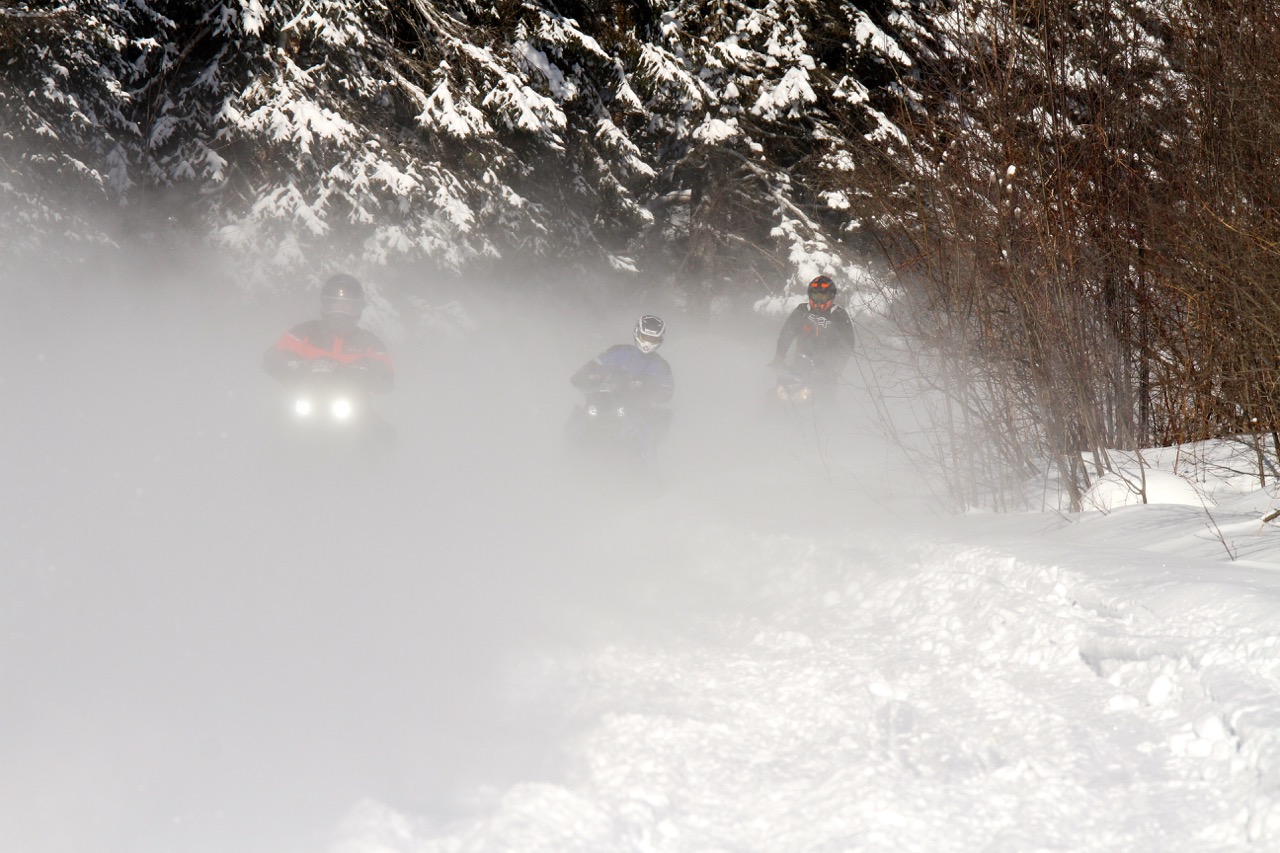
Photo courtesy of Destination Ontario
Eat A Hearty Breakfast
Staying warm while snowmobiling starts long before we go riding. Always remember that it’s easier to stay warm than it is to heat up again after being cold. Accordingly, one great starting warm tip is to eat a hearty breakfast of nutritious foods that take longer to digest. These choices can increase your body temperature and make you feel warmer. Such items are high in healthy fats, proteins and carbohydrates, including bananas, oatmeal porridge, potatoes, eggs, and whole wheat bread. Among the best drinks for starting warm are coffee, ginger tea and hot chocolate.
Wear Warm Clothing
The next important starting warm tip is dressing to stop the cold. First, pay special attention to what’s worn under your snowmobile suit, because those layers make all the difference for retaining body heat. Also, I find that my TekVest adds a layer of extra warmth for my torso, along with protecting it from serious injury.
Second, having the right purpose-made outer wear will effectively block out the cold.
Third, keeping our hands warm and feet toasty makes us more comfortable all over, because our body reacts to cold extremities. It tries to transfer core heat to them, thereby increasing the probability of having a chilly torso. That’s why I wear FXR Heated Recon gloves. Plus, I’ve also had decent results with ThermaCell Heated Insoles.
Fourth, be sure that all gear fits comfortably, but not tightly. Why? Because warm air needs room to circulate inside the gear and if it’s very close-fitting that can’t happen and you’ll get cold faster. Besides, anything that tight can also feel constricting, which can get uncomfortable while riding.
Bottom line: if we don’t have the right cold weather gear from the get-go, you’re probably going to have difficulty staying warm on cold days.
Adapt To The Weather
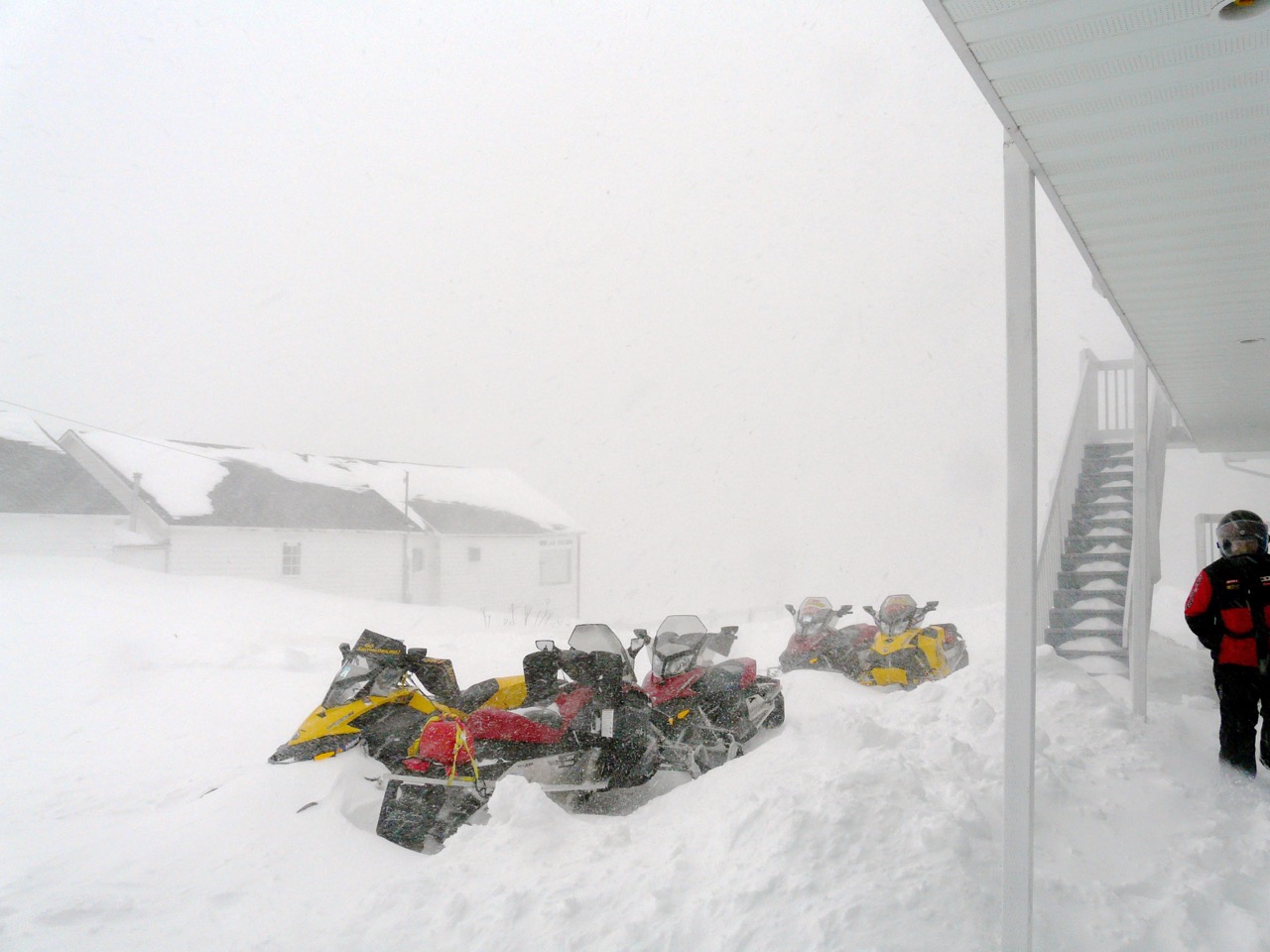
Photo © by Craig Nicholson
Assuming that our gear is well taken care of, pre-departure preparations should include comparing several weather forecasts for the area we want to ride that day. Pay particular attention to the temperature range, the windchill, wind strength and how sunny it’s supposed to be. If it’s a deep freeze all day, maybe we should consider postponing our ride. If it’s too cold early in the morning, how about a later start? Also check whether the mercury is expected to plummet later in the day so we can adapt our ride accordingly. Sure, any weather prediction can be uncertain. But generally, forecasts on the morning-of are as reliable as it gets.
With the weather info in mind, we should reconfirm our route status and pit stop availability. Are there other trails or services that could be back-ups if necessary? Is our intended distance for the day still realistic given the temperature and who’s going?
Dress for the coldest expected temperature, remembering it will be even colder when on a moving sled. It’s always better to be too warm and able to take off a layer than to be too cold and not have anything else to put on. So, make sure to pack extra under layers and also have space on board to store anything taken off as the temperature rises. If riding with a passenger, make sure they bundle up even more, because it’s a fact that the second rider on a sled gets colder, faster and longer.
Dressing For A Warm Start
Other good starting warm advice includes not putting an already cold body part into snowmobile gear. For instance, if feet are cold from walking on a cool floor inside, get them warmed before booting up. If a chill occurs from an open exterior door prior to gearing up, stand in front a heat source for a few minutes to warm up before dressing. Or crawl under the covers!
Next, don dry and pre-warmed gear, especially boot and gloves. Warming can be achieved by hanging gear in a hot place, like near the furnace or over heating vents. Preferably overnight, because putting on any damp gear is a sure recipe for getting cold fast. Also, try to avoid climbing into gear that’s bone cold from being carried in a trailer during the drive. Or left in a truck overnight.
On arctic days, I’ve even been known to stick a hair dryer inside my boots for a couple of minutes just before putting them on. Often, I’ll also stick a chemical toe or foot warmer to the bottom of my snowmobile socks in the morning. Plus, a larger warmer positioned in the lower centre of my back, on the outside of the later closest to my skin, not directly on it. And carry spares, if replacements are needed for later in the day.
Other Warm Start Tips

Photo © by Craig Nicholson
Once I’m fully dressed, I move to a cooler place that’s still indoors if possible, while waiting for others to be ready. This way, I don’t overheat and start sweating inside. Or get a chill on by standing outside. And by the way, remember that it’s better to start the sled before getting fully dressed. Doing so avoids extra standing around fully dressed in the cold while it warms up. Also, pre-starting enables any on board electrically heated items to warm faster after starting to ride. Pre-starting is also a great way to make sure all sleds are ready to go at the same time. And if not, then at least to avoid waiting around outside getting cold while a buddy tries numerous times to get a difficult one going.
Starting warm each morning is also a great reason to park the sleds inside overnight if possible. Also, to fuel up all sleds the night before. That way, no one gets cold in the morning while pumping gas before departing.
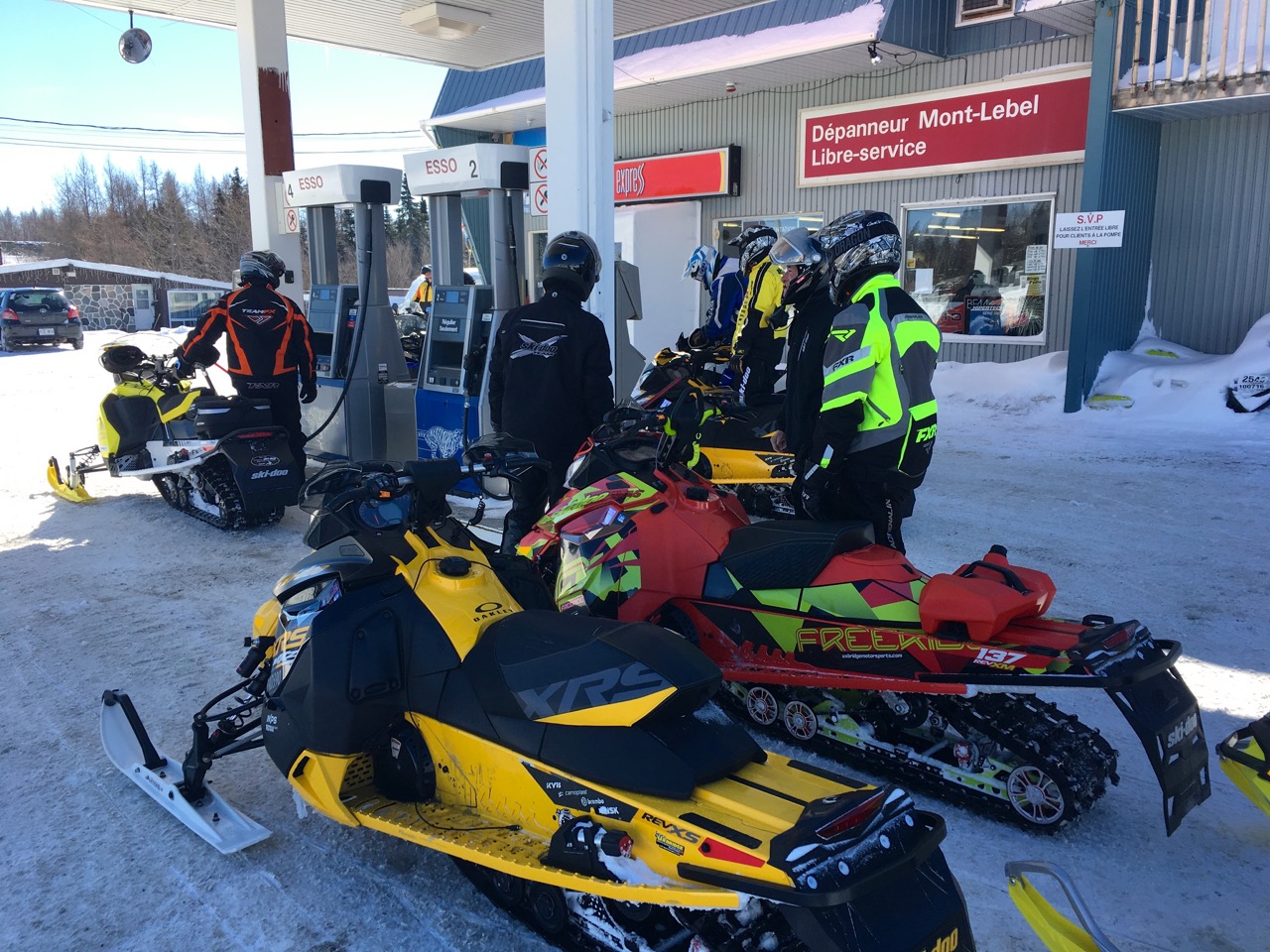
Photo © by Craig Nicholson
Staying Warm While Snowmobiling Means Riding Warm
Snack Frequently
As with starting warm, staying warm while snowmobiling depends on keeping our bodies fuelled with nutritious food. Just like a wood stove, a body needs continual flow of fuel to keep pumping out the heat. So, even if the plan is to have lunch inside at a restaurant, grab a quick snack to keep stoked every time there’s a stop on route. Handy, no-mess snack options that fit easily into an interior pocket include trail mix, energy bars, chocolate-covered nuts, dried fruit or string cheese. Chocolate bars and candy are better than nothing, but second best as choices for riding warm because their effects aren’t as long-lasting.
Drink Often
At the same time, don’t forget about fluid intake, even if not thirsty. A couple of sips of water frequently will help prevent the dehydration that saps body heat and makes us feel colder.
Water in a bottle will freeze eventually, so delay the process by trying this. Pre-heat a thermal container by filling it with hot water and let stand for about 10 minutes. Then empty and pour in room temperature or warm water to keep it liquid longer. Besides, avoiding cold water to drink is better for maintaining body heat.
Three final drink tips. One, if the lid of the thermal container screws on tightly with no chance of leaking, try carrying it upside down. Why? Because water generally freezes in a container from the top down. So if the drinking end is downwards, it’s less likely to be frozen shut when you want a drink. Two, don’t take a drink container with a narrow top or sipping straw as either will freeze faster than a wider opening. And three, fully fill the container, because the emptier it is, the faster the liquid inside loses heat. This is also a good reason to top up with warm or room temperature water when possible.
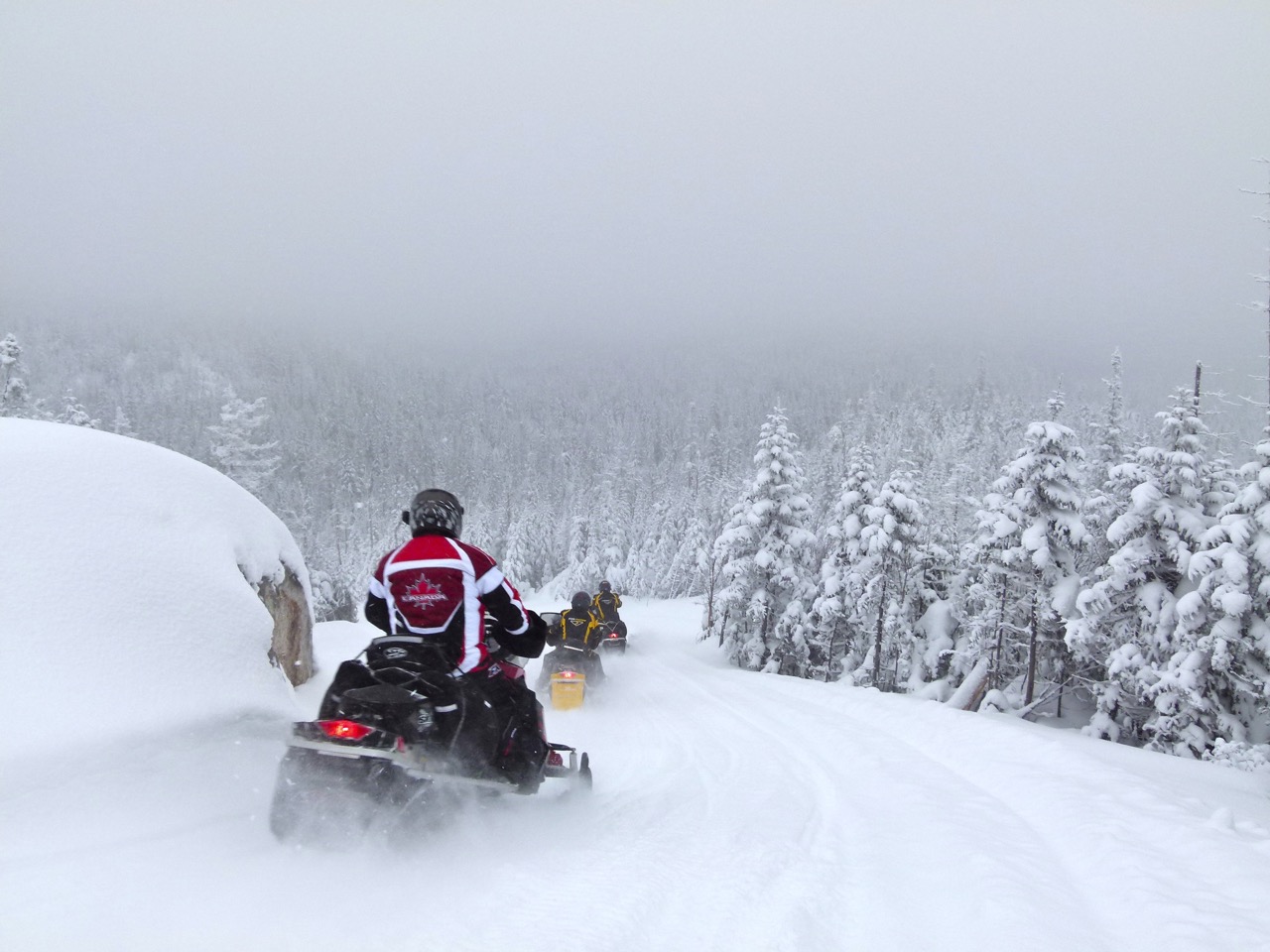
Photo © by Craig Nicholson
Stop To Pee
The act of bladder emptying allows the body a little more energy to stay warm. So don’t be riding with your legs crossed, just let it go! Yes, it’s easier for men, but not impossible for women – there are several handy urination devices available to help. Note: when my wife read this, here’s what she said: “It’s easier to go ahead on the trail a short ways, then squat to pee facing the sled while hanging on to the ski handles. If two ladies go together and park their sleds in line, they can do their business between them.”
Be Aware
Don’t get so caught up in the thrill of the ride that monitoring body comfort gets ignored. Catching a chill usually comes on slowly, so focus on any body parts prone to get cold first. These normally include toes and fingers, but first signs of cold can also show up on nose or ears. Or anywhere that a cold draft can sneak inside a snowmobile suit.
So don’t try to tough it out if when a chill starts. Stop and rearrange gear to block the draft, put on a layer or add a chemical warmer. That’s also a good time to check riding companions for frostbite spots on the face and any other signs they may be getting cold.
Finally, start the return ride early enough to get back while there’s still daylight. As soon as dusk sets in, it also starts getting much colder.
Restaurant Lunch: Re-Warm The Gear
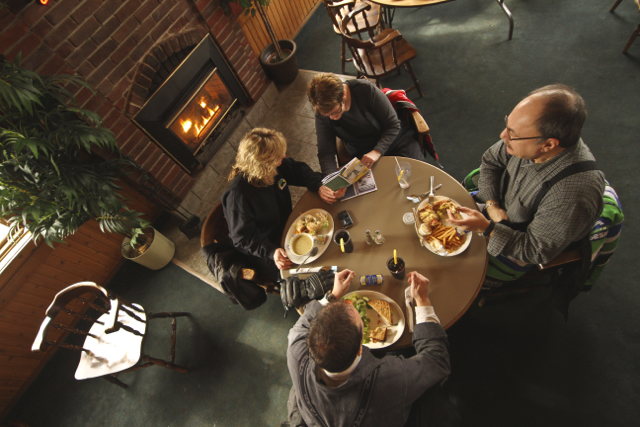
Photo courtesy of Destination Ontario
When stopping at a restaurant for lunch, try to spread gear out near a heat source to dry and warm up. Pay special attention to drying helmet breath deflectors, neoprene masks, balaclavas, and other face coverings that tend to get wet. Make sure not to set helmet or gloves on a wet spot. If the restaurant is warm enough and it’s possible, strip off any top under layers to avoid overheating while indoors.
Sometimes if the exteriors of my boots are dry, I even slip my feet out and rest them on the boots while I eat. I just have to remember to put them back on before I walk around! Lunch time is also when I check all my various device batteries and replace the ones in my heated gloves if needed.
Restaurant Lunch: Fuel The Furnace
For riding warm, my restaurant lunch is all about refuelling with food that’s high in healthy fats, proteins and carbohydrates, just like breakfast. Hot choices like soup, stew, chilli, toasted western or grilled cheese work well for me, washed down with hot chocolate, coffee or herbal tea, not a cold drink. And no alcohol, because it drops your core body temperature just when you need all the heat you can get for the afternoon’s ride.
Outdoor Lunch Tips
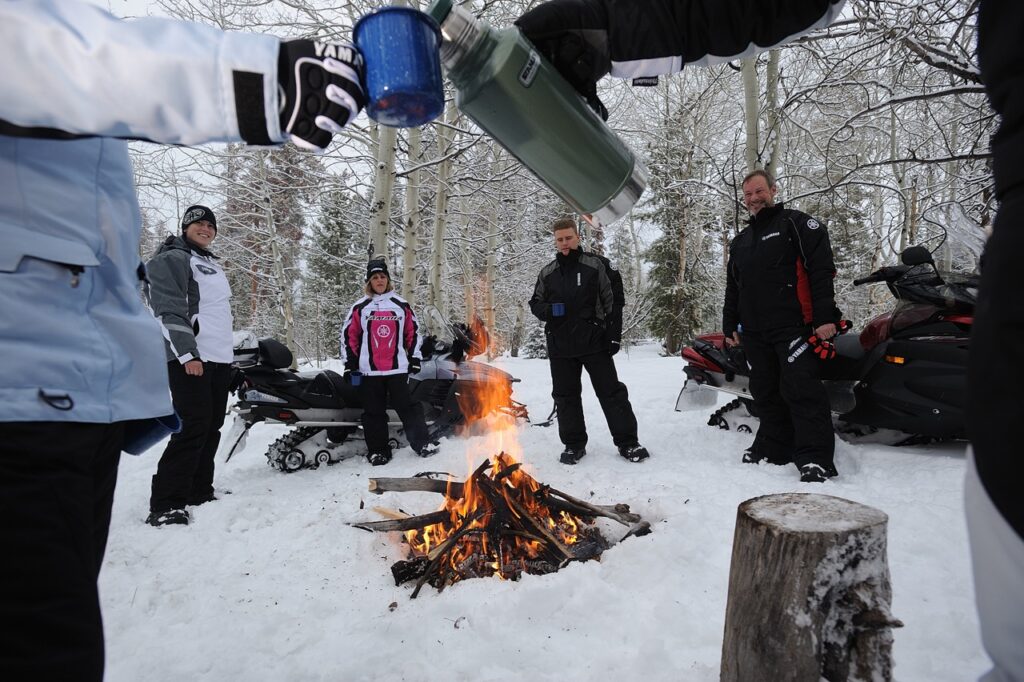
Pre-COVID Photo courtesy of Yamaha Motor Canada
If you opt for a trailside lunch, my riding warm advice is similar, albeit slightly more difficult to achieve. Especially my re-warming tips when there’s no fire or shelter. So, my first advice for lunching outdoor is to keep it short. What’s more, try to stop in a sheltered spot if it’s windy. If sunny, take your lunch break in direct rays. Whatever the choice, pull over to the far right of the trail. Then, make sure it’s a safe place to stop, with good sight lines in both directions for oncoming sleds.
If possible, leave your helmet on while eating. If not, wear a warm toque. Either will not only keep your head warm, but more importantly, prevent the rapid heat loss that occurs through a bare head. Plus if you take it off, the helmet’s inside will be cold when put back on. That’s one reason I wear a modular helmet, because I can eat comfortably by simply flipping up the entire front piece.
Outdoor Lunch Options
If you want something hot to eat or drink for your lunch outdoors, you’ll need the right insulated container. Typically, the ones for drinking hot liquids are relatively tall and narrow. Meanwhile, the ones for eating food like stew or chilli are shorter and wider to enable use of a spoon easily. Check out various popular options on either the Thermos or Stanley websites. Alternatively, for another heated lunch option, check out these food warmer videos for Muff Pot and Hot Pot, or this link to Hot Pan. Or try a portable oven. That is, if you can find space under your hood!
Alternative lunch ideas include jerky, energy bars, dried fruits, nuts, sausage or kielbasa, cheese, crackers, flavoured tuna in self-opening cans or snack packs (store cans in an inner pocket while riding) or Nutella Pretzel & Bread Sticks. A personal dessert favourite is a bite-sized, oatmeal & dark chocolate treat called Heavenly Hunks!
Leave Tracks, Not Trash
Whatever your choices for lunch or snacks, always remember to carry out the trash. It takes up less space that the food itself did, so there’s no excuse for littering the trails with garbage!
Staying Warm While Snowmobiling Storage Options
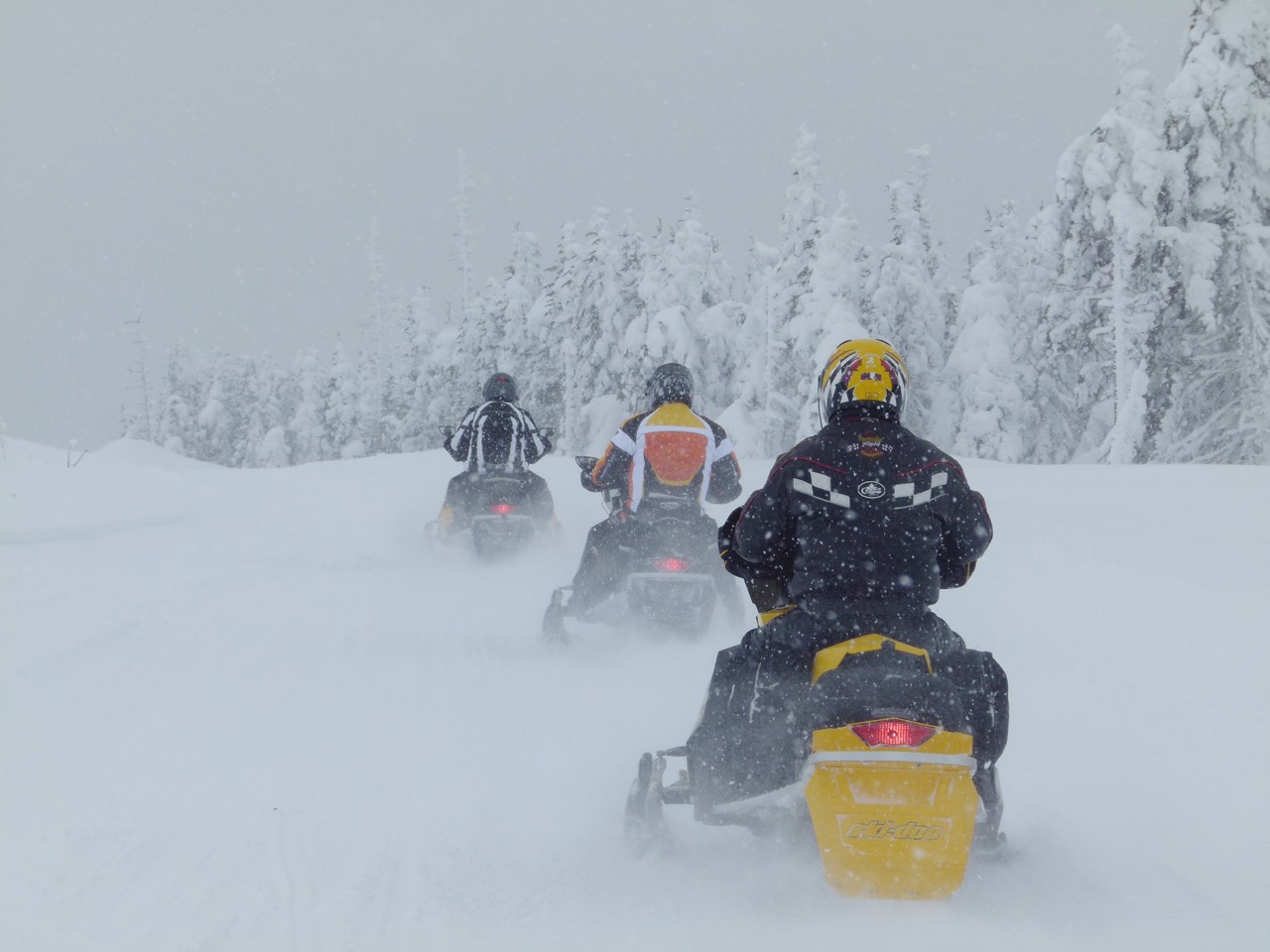
Photo © by Craig Nicholson
By now everyone may be wondering how to carry everything for staying warm while snowmobiling. Even for day rides, I’m going to ride this winter with most or all of my touring luggage. That includes LinQ System gear and saddlebags. For those who don’t ride a Ski-Doo snowmobile, LinQ adapters kits are available. Alternatively, consider a snowmobile backpack.
In the spirit of self-sufficiency, everyone should carry their own warmth supplies, extra fuel & oil, and emergency gear on their own sled. That way, everybody has what they need. And if anyone gets separated or lost, each person can be self-reliant for at least a while.
After all, better to have too much carrying space than not enough. But if you need even more room to accommodate gear for the whole family, consider adding a snowmobile caboose, ice fishing sled or utility toboggan to your riding fleet. In my opinion, the caboose style that sits on two skis, is a more controllable and stable choice for trail usage.
My Last Word on Staying Warm While Snowmobiling
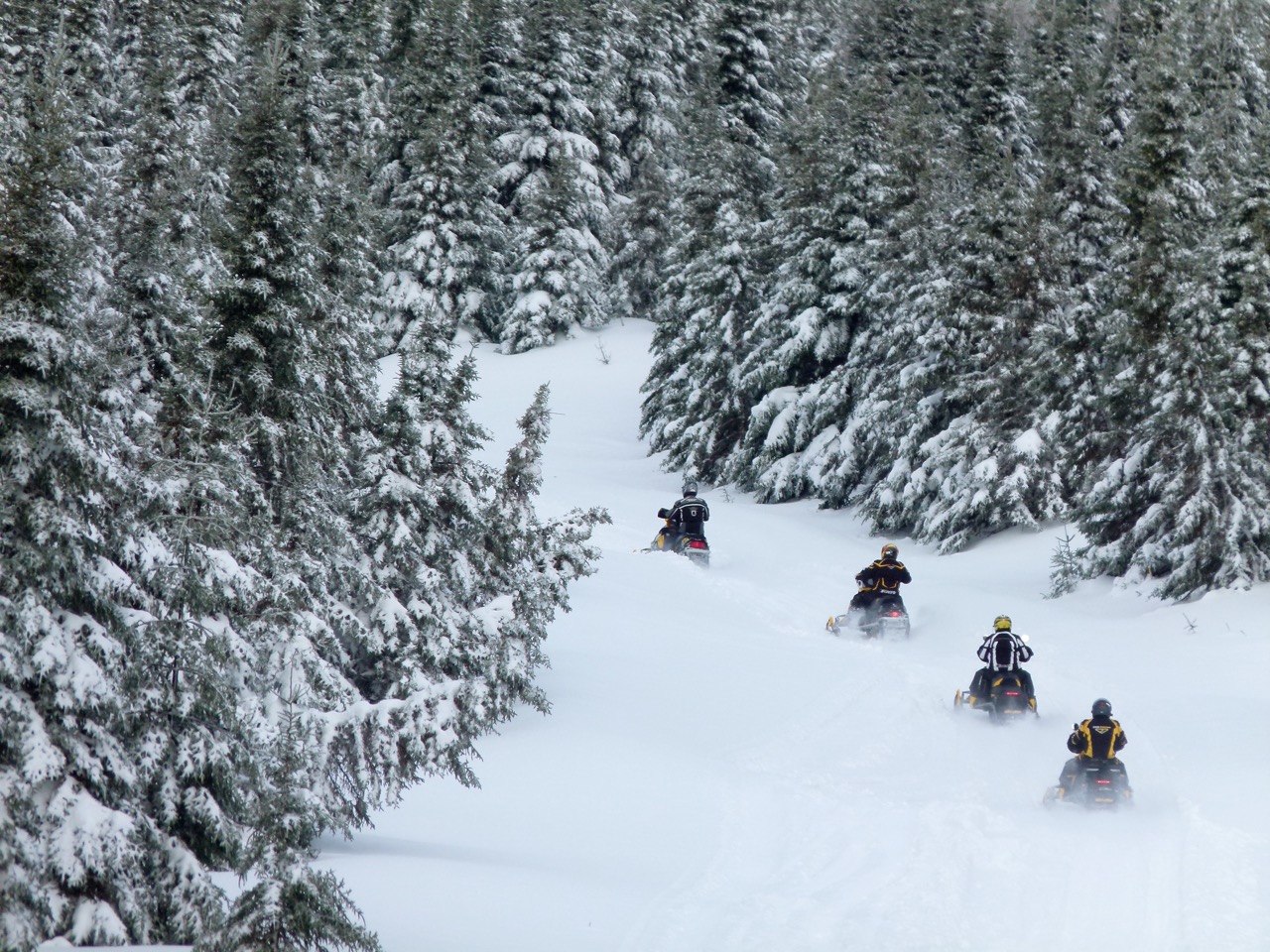
Photo © by Craig Nicholson
I expect my staying warm while snowmobiling tips to be a work in progress all winter. Besides, I’m sure there are things I’ve overlooked already. But as I get back into my self-sufficient groove, I’ll update this article. Also, I welcome and appreciate any and all input from my fellow trail riders from your own staying warm while snowmobiling experiences. Hopefully, novice riders will take note and also look at check out my beginners tips. After all, we’re all in this crazy winter together, so let’s make the best of it!
The tips and advice in this blog are the opinions of the author, may not work in every situation and are intended only for the convenience and interest of the reader, who has the personal responsibility to confirm the validity, accuracy and relevancy of this information prior to putting it to their own use.
